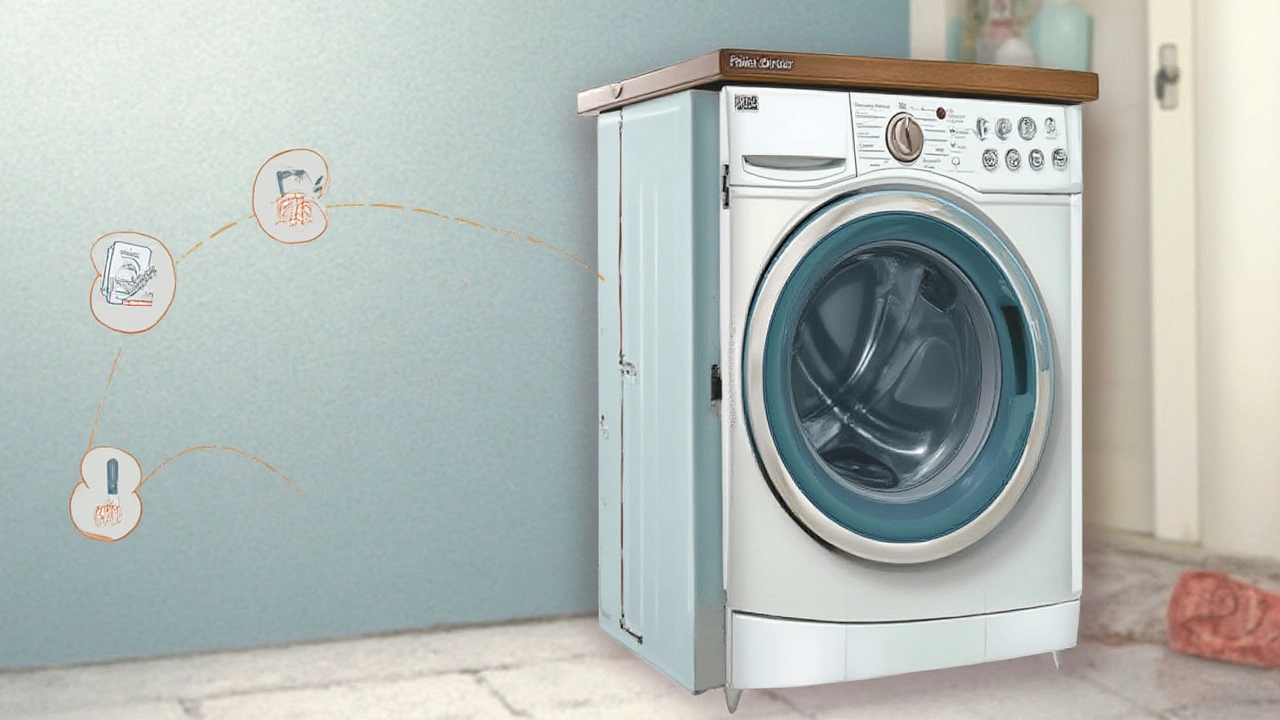
- 5 Jul 2025
- Gideon Thornton
- 0
Ever read the warranty on a tumble dryer and wondered if these numbers mean anything in real life? It's not your imagination; few home appliances get such a brutal workout as the good old dryer. Think about it: it’s just sitting there, spinning, heating, and blasting away moisture several times a week, maybe even every day. Most people don’t realize how much they're relying on that box until it gives up—and then it’s a scramble to dry socks over radiators or hang laundry around the house. So, what's the real shelf life of one of these hard-working machines?
Average Lifespan: What the Numbers Say
Tumble dryers on average live somewhere between 10 and 15 years. That’s not a wild guess—it comes straight from real-world surveys and manufacturer data. Big brands like Bosch, Samsung, Whirlpool, and LG typically design their dryers to last at least a decade. Consumer Reports backs this up: they found the average tumble dryer lifespan hovers around 13 years for most homes. Obviously, every household is different—how a college student uses a dryer in a shared flat versus how a family of five uses it can change the equation.
Let's get specific for a second. According to industry research, if you use your dryer three times a week, that adds up to about 150 cycles per year. Multiply that by 10, and that's over 1,500 intense sessions of tumbling, heating, and cooling down. Some higher-end models, especially those labeled as “commercial-grade,” can surpass 5,000 cycles. But don't get too cozy. Even the best machines will show their age: belts start squealing, sensors fail, and heating elements burn out.
Want hard numbers? Take a look at this:
| Brand | Expected Lifespan (Years) | Warranty (Years) |
|---|---|---|
| Bosch | 12–15 | 2 |
| Whirlpool | 10–13 | 1–2 |
| LG | 10–15 | 1–3 |
| Samsung | 11–14 | 1–2 |
| Beko | 8–12 | 1–2 |
It’s worth noting those warranty periods are usually way shorter than the average lifespan—you’ll be on your own for repairs after the first few years.
Why Some Dryers Die Early – and Others Just Keep Spinning
The biggest thing that decides if your tumble dryer will soldier on or pack it in is usage. If you're running mammoth loads daily, the appliance is going to feel it. There’s also the type of dryer: vented, condenser, or heat pump models all have different stresses on their systems. Vented dryers are often simpler and easier to fix, but the extra moving air means more dust and lint buildup, which can slowly suffocate the machine if you skip maintenance. Heat pump dryers are much more energy-efficient, but their complex guts don’t always take kindly to being overstuffed or left uncleaned.
Another oddball factor? Location. Stick your dryer in a dank basement with no ventilation and you’ll invite mold and corrosion. Put it in a tiny closet that traps heat, and you risk overheating and early burnout of components. My pal Eddie learned this the hard way when his three-year-old condenser dryer started tripping the power in his cramped under-stairs space. The culprit? A big ball of lint and no room for the hot air to escape.
Water hardness makes a difference too—seriously! It doesn’t just mess up your washing machine. If you live in an area with really hard water, minerals can get into the dryer, especially with combined washer-dryer units, and clog up inner parts, leading to less efficient drying and more breakdowns. Homes with lots of pets and kids usually have machines working overtime with enormous, often overloaded, laundry piles and more lint.

Secrets to Making Your Dryer Last Years Longer
Most people ignore their dryers until something goes wrong. That's a mistake. Just a few simple habits can buy you several extra years before you face a replacement bill. First off, clean the lint filter after every single use. You’d be amazed how quickly a clogged filter overheats the unit or causes fires. Once a month, go one step deeper: pull out the filter and vacuum around the housing, and if you can, snake a flexible cleaning brush or vacuum attachment down the vent pipe.
If your dryer has a condenser unit or water tank (usually on heat pump and condenser models), empty and wash those out regularly—stale water and trapped fibers will slow things down. Wipe the sensors (they’re often metal bars inside the drum or door area) with white vinegar on a cloth to keep them reading moisture levels accurately. I once ignored neglected sensors, and ended up with everything on “bone dry” even when the clothes came out damp.
Level the machine properly so it doesn’t wobble around. Not only does this cut down on annoying rattles, but it reduces stress on the motor and bearings. If you move house, always let the dryer stand upright for at least an hour before use, especially after tipping it off the dolly—let any oils settle back. Don’t overfill the drum; bulky comforters or half the closet thrown in at once strains internal parts and means longer cycles that wear out the motor faster.
Here’s a checklist to squeeze more years from your dryer:
- Clean lint filter after every use
- Check and clean vent pipe monthly
- Wash condenser or water tanks as needed
- Wipe moisture sensors
- Level the dryer
- Avoid overloading
- Have a pro inspect internal belts and parts every couple of years
Don't ignore strange noises. That squeal could be a worn drum belt, or the thumping could mean the drum rollers are shot. Catching it early can mean a $25 fix, rather than destroying the motor and needing a whole new machine. My neighbor Jeff once ignored scraping sounds for months, only to be left with a seized motor—and a $500 expense that could’ve been a cheap DIY repair if caught early.
Replacing Versus Repairing – And When to Move On
Even with the best care, there comes a day when your dryer starts to act its age. At that point, you’ll weigh up fixing versus replacing. Here's where things get real: if your machine is over eight years old and quotes for fixing a broken heater or main circuit board climb above half the cost of a new one, it's usually smarter to replace, unless you’re a repairs whiz or really attached to the machine (some folks swear their 20-year-old appliance dries better than anything new). Dryers made before 2013 often last longer and can be fixed with cheaper, more available parts. Newer models may have more complex electronics, which can be tricky and expensive to repair.
Energy usage matters too. Modern tumble dryers, especially heat pump models, can slash your yearly electricity bill by up to half compared to old-school vented models. According to a 2024 EU study, replacing a 15-year-old vented dryer with a high-efficiency model can save up to $150 per year in energy costs. Over a few years, that’s enough to help pay for the new appliance.
Of course, sometimes all it takes to bring an old dryer back to life is a $20 thermostat, a belt, or a new door latch. Parts for popular brands are widely available online, and heaps of YouTube tutorials can guide you through repairs. That being said, if your model sputters on and needs callouts every other month, peace of mind often trumps saving a buck. Evelyn reminds me she’d rather have a trusted new dryer humming quietly than wrestling with endless breakdowns and half-damp school clothes.
One quick calculator for when to throw in the towel: if your dryer is past the tumble dryer life expectancy, is out of warranty, and would cost you more than 40% of a new model to fix, start shopping around. If repairs are under $100 and you’ve had no other trouble, a fix is probably the way to go.
In the end, treat your tumble dryer well and it’ll return the favor, sometimes for years beyond what the manufacturers predict. Take care of those little chores, watch for the warning signs, and you might just find your appliance hanging in there long after others have been scrapped. Who knows, yours might make it into the “vintage dryer” hall of fame. Keep it spinning.

